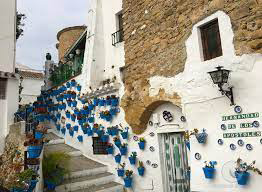Iznájar
Iznájar
Municipio perteneciente a las Sierras Subbéticas, al sur de la provincia, en límite con la provincia de Granada y Málaga. Su término municipal está formado por extensos campos ondulados de olivos y por terrenos de sierras, y se encuentra incluido en el Parque Natural de la Sierra Subbética, que presenta un relieve de fuertes elevaciones calizas y valles poblados de encinares y quejigales y álamos blancos en las riberas de los cursos de agua.
El pueblo, situado sobre un cerro que domina el gran embalse de Iznájar sobre el Genil, es un núcleo apiñado de calles estrechas, sinuosas y en cuesta con casas blancas que parece colgado sobre el agua, formando una estampa de gran belleza y tipismo. El Castillo, situado en la parte alta, es el elemento perfecto para completar el singular conjunto.
Historia
La población fue llamada por los árabes Hins Ashar (castillo de piedra), lo que puede darnos una pista de su fundación en los alrededores del siglo VIII (se considera fundador a Fald ben Salama). Durante la Baja Edad Media, al ser frontera entre el reino de Granada y los cristianos circundantes, cambiará alternativamente de manos.
En el siglo XII, según al-Idrisi, tenía una numerosa población y un mercado muy frecuentado.
La última toma de la ciudad por parte de las tropas cristianas fue en 1431, bajo el reinado de Juan II.
Tras las luchas dinásticas entre Enrique IV y el infante Alfonso, en 1466, la villa pasará a depender de Diego Fernández de Córdoba, señor de Baena y conde de Cabra, junto con las villas de Rute y Zambra.
En el siglo XIX, Iznájar fue cuna de las bases de apoyo más importantes a la sublevación protagonizada por el albéitar de Loja, Rafael Pérez del Alamo (en otras fuentes Pérez del Llano), dando así comienzo a una gran sublevación popular, la primera de las que Díaz del Moral llamó "socialismo indígena".
Personajes destacados
Julio Burell, ministro.
Cristobal de Castro, escritor y periodista (1874-1953).
El castillo de Iznájar dio nombre a la población, referente obligado de su imagen y de su conformación urbana. Prototipo de un «hisn» árabe al tener las características propias de los castillos roqueros de ascendencia islámica, los cuales se localizaban en el punto más elevado del espacio a defender. Las laderas norte y noreste del promontorio son escarpadas actuando como muralla natural, el resto presenta un perfil más suave que ha permitido el asentamiento del caserío.
Tradicionalmente se ha considerado la totalidad de este espacio de época emiral, de mediados del siglo VIII, siendo reformado en el siglo X, aunque los últimos trabajos de investigación lo datan en el siglo XII. Fue remodelado en el S. XVIII para acondicionarlo como vivienda del administrador del Duque de Sessa, función que mantuvo hasta principios del S.XX. Tras años de abandono, fue adquirido a sus últimos propietarios (el Conde de la Revilla y hermanos) por el Ayuntamiento de Iznájar en el año 1991.
Las Sierras Subbéticas, incluidas en la red Europea y Mundial de Geoparques y avaladas por la Unesco desde 2006 debido a su interés geológico, emergen de los fondos marinos durante el plegamiento alpino. De tal modo, en las huellas de su relieve se narra la más bella historia de la tierra en sus últimos 250 millones de años;… el hombre, afanado en dejar impronta en tanta historia, le ha colado cuñas de verde oro líquido: aceite de oliva.
El macizo, aparentemente, se levanta como una gigantesca e inexpugnable mole montañosa al que ponen cerco los llanos de Priego y Alcaudete, la hoya de Antequera y la campiña cordobesa. Pero el agua, por disolución de la roca caliza que la forma, ha ido modelando relieves a su antojo creando picachos, aristas y cañones, como los de Sierra Horconera (Rute) y Gallinera (Carcabuey); dolinas -el Cortijo de la Majada o Los Hoyones-; fértiles navas como el poljé de la Nava; acanaladuras, surcos y crestas -lapiaz de Los Lanchares-; y, cuando el líquido elemento cuela en las entrañas de la montaña, da lugar a simas y galerías -simas de Cabra y Sierra Gallinera, cuevas de Los Murciélagos y del Fraile, tajos y cañones como el del río Bailón-, y finalmente surgencias y fuentes, como la espléndida del Rey en Priego y del Río en Cabra.
Los cauces fluviales exhiben una vegetación exuberante de olmos, fresnos y álamos que cobijan cangrejo de río y la musgaña de Cabrera, una pequeña musaraña que en la provincia sólo está presente en estas aguas. Según se asciende, la insolación va a determinar un paisaje con plantas de porte achaparrado, hábitat de la cabra montés, mientras que en la umbría se localizan manchas de encina y quejigo, y un sotobosque formado por majuelos y cornicabra que permiten la existencia de un buen número de aves -trepador azul, piquituerto o pinzón real-. Dominan en este ámbito las colonias de musgos, líquenes y hongos, cuya importancia y diversidad ha motivado la creación de un jardín micológico en la aldea priegense de Zagrilla. Las crestas más altas están colonizadas por plantas de porte espinoso y almohadillado, como los piornos finos y el piorno azul. En las grietas suelen hallarse especies escasas como la rara orquídea Orchis ustulata y la liliácea Allium reconditum. Encontramos en estas cotas las especies vegetales más interesantes, algunas de ellas endémicas de estas sierras, como Festuca cordubensis, Hypochaeris rutea, Melica bocqueti, Mercudera androcymbioides y Narcissus bugei o flor de San José. Es éste el lugar idóneo para las aves rupícolas, como buitre leonado, águila real y perdicera, halcón peregrino o búho real.









